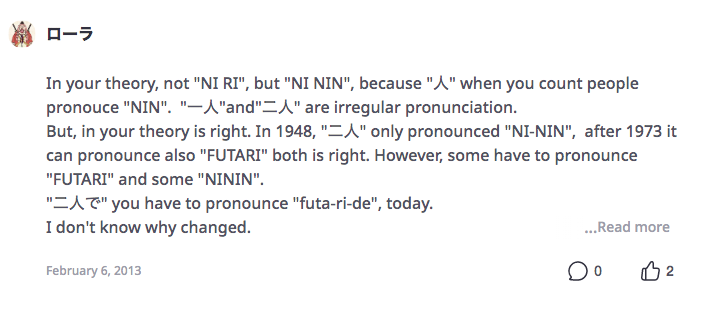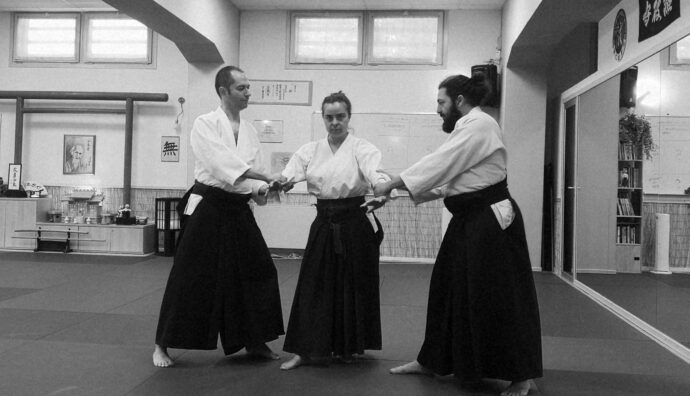Do they say “ninin dori” or “futari dori“?
A few years ago, the examiners that presided over my exam asked me to show techniques in “ninin dori”.
And so far, nothing strange. Except that, while I started making my ukes go against each other, the examiners started a lively discussion.
“Hey, in Japanese, you don’t say ninin, you say futari…”
“No! It’s called ninin!”
“They all say futari, because actually you are counting people…”
“Saito Sensei always said ninin.”
This unexpected show lasted a few minutes, allowing us to recover our breath, since we had stopped and since in the heat of the discussion, the examiners had momentarily forgotten about me (just to ask me all over again, but that’s another story).
Now, whether the techniques with two ukes simultaneously grabbing nage are called “ninin dori”, “futari dori” or “John Doeri”, for the purposes of a correct technical execution, it simply does not matter.
But it is a fact that Japanese terminology constitutes the backbone of the study of a martial discipline. The terminology brings with it the characteristics of the Japanese language and the language the elements of the culture and way of thinking of the people who speak it.
For everyone – and certainly for the first few years – the approach to terminology coincides with an act of faith. They tell you to count a certain way; that the techniques are called like this; that principles are called like that…
You do not even question yourself with any doubt about the actual correspondence to the truth. You put trust and confidence. You have to do that. Otherwise if you immediately start questioning everything, you are stuck.
Usually, especially in realities anchored to tradition -whatever is meant by this term- it is also frequent to hear fragments of sentences in Japanese (kuden, doka), or quotations attributed to this or that Sensei, from the Founder onwards.
Even in this case, what tools does a student have, on average, in order to orient himself/herself? Especially if the student is a beginner. People trust, receive these new sounds and, in direct proportion to the passion they put into practice and to the perceived credibility of their teacher, they in turn will become a kind of repeater of what they’ve heard and understood.
It is on these foundations that the tradition is based.
It sometimes happens, especially after several years of practice, that the desire to understand what has been received moves the practitioner towards a study of the Japanese language.
More and more practitioners, who often also have teaching roles, are entering this study. It’s a trend that indicates a healthy curiosity -and also the courage to want to elaborate again what is known under the new perspective that culture mediated by the Japanese language offers.
From the very first lessons, you enter a world in which there are relatively few rules, while numerous exceptions appear that our Western and logical mind immediately labels as very difficult both to understand and to catalogue.
Classifiers, for example. Counting a certain number of people will require a different classifier, for example, from counting the same number of oranges, which will change if you need to count sheets of paper…. And so on.
And that’s not all, because some families of classifiers bring archaic forms with them. So, if we have to count one person, we will say 一人 hitori, two 二人 futari, and from three onwards, more or less everything will go smoothly with one san-nin, yo-nin, go-nin (三人,四人,五 人).
So? Why if I have to count two people making a grab do I have to say ninin dori and not futari?
If already futari is an exception, ninin dori would be the exception of the exception.
Since as a good westerner we don’t like confusion that much, because it would be nice to understand something more, we looked for someone to be able to answer the question “Why do we say ninin dori?”
Either for my need. Both because it would be nice to be able to answer clearly to a question from a mate or a student.
So after some research I found a first answer at this link. I’ll post the screenshot below.

Basically “Roora” (Laura, who in her profile says she is Japanese -we couldn’t get in touch with her), states that until 1973 in Japan only “ninin” was said. From there on “futari” took over. As far as we are concerned, practicing a discipline founded not many decades ago, this explanation provides a suggestive frame. The point would be: since “ninin dori” is a categorized technique in Saito Sensei’s teaching and since “ninin” is a somewhat elderly voice, then this would be yet another evidence that would prove that Saito Sensei has done nothing but put down exactly what he heard and saw directly from Morihei Ueshiba. Elder the founder, aged the language: Yeah! We are practicing the original Aikido!
But was this answer enough? No.
So we asked our Japanese teacher, prof. Aya Nakata, from the Sakura Association of Turin more insights and her opinion.
The answer, rigorous in verifying the sources, confirmed that “futari” was a form already present in the books of the Nara period (710-784 AD). What a pity! The mental movie that we edited thanks to the previous interpretation crashed soooo miserably.
So, why?
Simply because, quoting the professor, the ambiguity of reading Japanese is “one of the most difficult parts of the Japanese language…even among Japanese people”.
Let’s take some examples.
For instance, 二人乗り (two-seater) can be read both 「ふたりのり」futari-nori and 「ににんのり」 ninin-nori.
Or 「二人組」 (in pairs) can be read 「ふたりぐみ」futari-gumi or 「ににんぐみ」ninin-gumi
While, for example 二人三脚 (three-legged) must necessarily be read 「ににんさんきゃく」ninin-sankyaku.
And with the disarming and elegant smile typical of a person of culture, Aya Sensei concludes:
“Unfortunately if you know, you know and if you don’t know, you don’t know…”
So why is it called “ninin dori”? Because that’s what they say, full stop. Probably it is to give emphasis to the enumeration of how to execute the grab. But it’s a theory.
The fact remains that the approach to the Japanese language and culture allows you to come into contact with a very deep feeling that is very different from ours. Almost complementary.
A world where “it’s done this way because it’s done this way” is still an important pillar of teaching that coexists with infinite exceptions and shades.
How can we welcome all this into our practice? With the awareness that “it’s done this way because it’s done this way” doesn’t mean having to carbon copy and to stubbornly repeat entire sentences if you don’t understand (and sometimes pronounce) them correctly. There is something touching in seeing the tradition spread. But under what conditions does the cordless telephone fulfill its role as a reliable communication tool?
In common experience, the difference between what is actually said and what is reported is wide.
A greater awareness of the meaning of the words, verbs, sentences that we hear and which we in turn report, can really give a perspective of greater freshness to the practice itself. Less dogmatic, more alive. Less addicted to the anxiety of becoming the clone of our teachers, more inclined to understand what that term, that movement, that perspective is saying to each of those present, right here, right now.
That’s why it sometimes makes sense to stop during your exam to hear the examiners discuss about “ninin” and “futari”.
Credits: photo courtesy Eleonora Rescigno, Fabio Berta, Hara Kai Dojo

